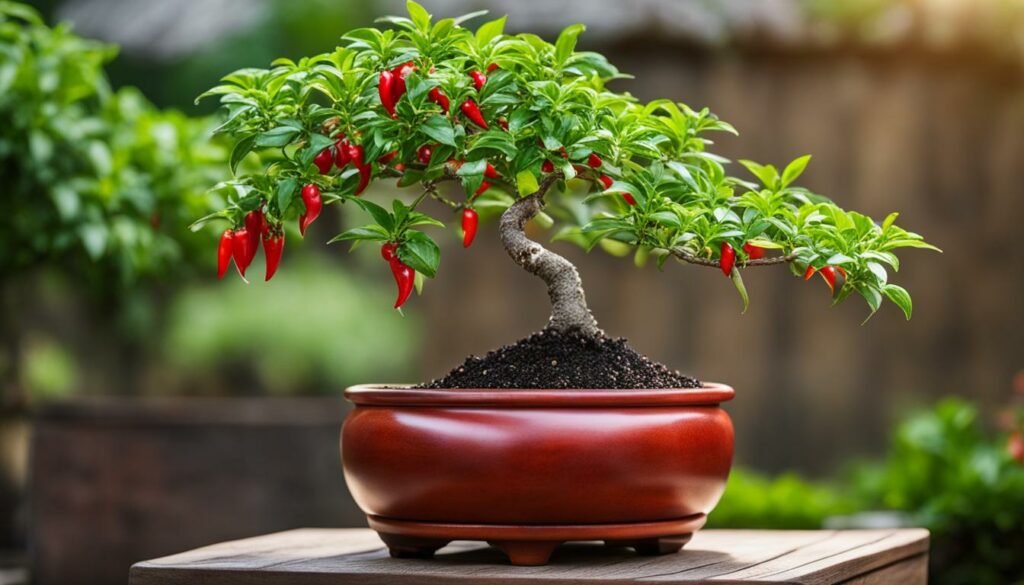Are you looking for a unique bonsai species to add to your collection? Look no further than the Chinese Pepper Bonsai, also known as the Zanthoxylum Bonsai. This charming tree species is highly sought after among bonsai enthusiasts for its piquant qualities and captivating features.
The Chinese Pepper Bonsai originated in China and boasts small, shiny leaves that emit a distinctive aroma when crushed. Its bark is speckled with prickly thorns, adding to its allure and creating a textured, visual appeal. The Chinese Pepper Bonsai is a relatively easy tree to maintain, with proper care ensuring its longevity and vibrancy.
Key Takeaways:
- The Chinese Pepper Bonsai, also known as the Zanthoxylum Bonsai, is a unique addition to any bonsai collection.
- This bonsai species originates from China and boasts distinctive features such as small, shiny leaves and thorny bark.
- The Chinese Pepper Bonsai requires proper care to ensure its longevity and vitality.
- With easy maintenance and captivating attributes, the Chinese Pepper Bonsai is highly sought after among bonsai enthusiasts.
- The next sections will explore the specifics of the Chinese Pepper Bonsai and provide care tips, propagation methods, styling techniques, and more.
Understanding the Chinese Pepper Bonsai
Chinese Pepper Bonsai, also known as Zanthoxylum Bonsai, is a unique bonsai tree species with a spice that will give a kick to your garden. Originated from China, it is known for its robustness, durability, and spiciness. These features make the Chinese Pepper Bonsai highly sought after in the bonsai community. It is an excellent addition to any bonsai collection and provides a unique touch to your garden.
This bonsai tree species has distinctive features that set it apart from other zanthoxylum species. The Chinese Pepper Bonsai has small green leaves and thick stems with sharp spikes known as thorns. These thorns make it a good bonsai species for security in your garden. Additionally, the trunk bark has a unique texture that ranges from light to dark brown.
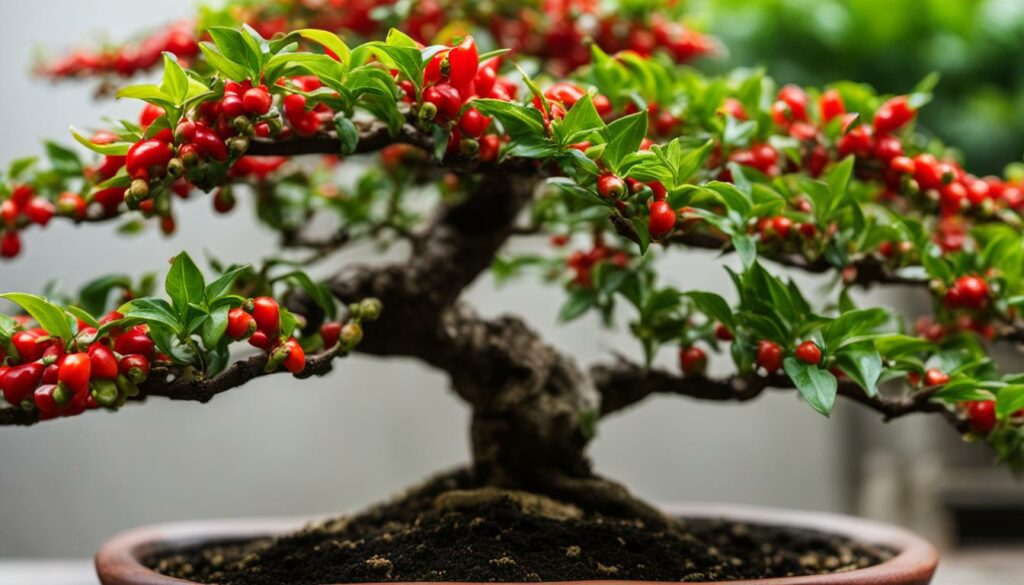
Chinese Pepper Bonsai in Comparison to Other Zanthoxylum Species
The Chinese Pepper Bonsai is often compared to other zanthoxylum species like the Japanese Pepper and Szechuan Pepper. One distinction is that the Chinese Pepper Bonsai has fewer thorns and a more aromatic scent than these species. It also has a more branching structure, making it an ideal bonsai species.
Caring for Chinese Pepper Bonsai
Caring for the Chinese Pepper Bonsai is not as challenging as many other bonsai species. It thrives best in a well-draining soil mixture with regular watering and fertilization. The Chinese Pepper Bonsai also requires bright and indirect sunlight and a constant temperature above 50℉.
Tip: During winter, it is advisable to move the plant to a warmer area to avoid frost damage.
Unique Qualities of the Chinese Pepper Bonsai
The Chinese Pepper Bonsai has diverse qualities which distinguish it from other bonsai species. Apart from its spicy scent and taste, it has medicinal qualities like anti-inflammatory, analgesic, and anti-carcinogenic properties. The Chinese Pepper Bonsai has also been used in traditional medicine as a treatment for various ailments.
The Chinese Pepper Bonsai is a unique and valuable addition to any bonsai collection. Understanding its origins, distinctive features, and caring techniques is essential in its cultivation.
The Allure of the Zanthoxylum Bonsai
The Zanthoxylum Bonsai, also known as Chinese Pepper Bonsai, is a unique creation that offers much more than its culinary counterpart. One of the main attractions of this bonsai species is its captivating aroma, making it a perfect addition to any room.
Alongside its fragrance, the Zanthoxylum Bonsai also boasts of a unique foliage structure characterized by fine branches and leaves. This intricate design captures the eye, rendering the Zanthoxylum Bonsai a conversation starter and a talking point.
When added to a bonsai collection, the Zanthoxylum Bonsai brings excellence and idiosyncrasy, making it a prized possession for many bonsai enthusiasts. Not only does it offer visual and aromatic delights; it also challenges the grower to expand their knowledge and skill set in this unique bonsai species.
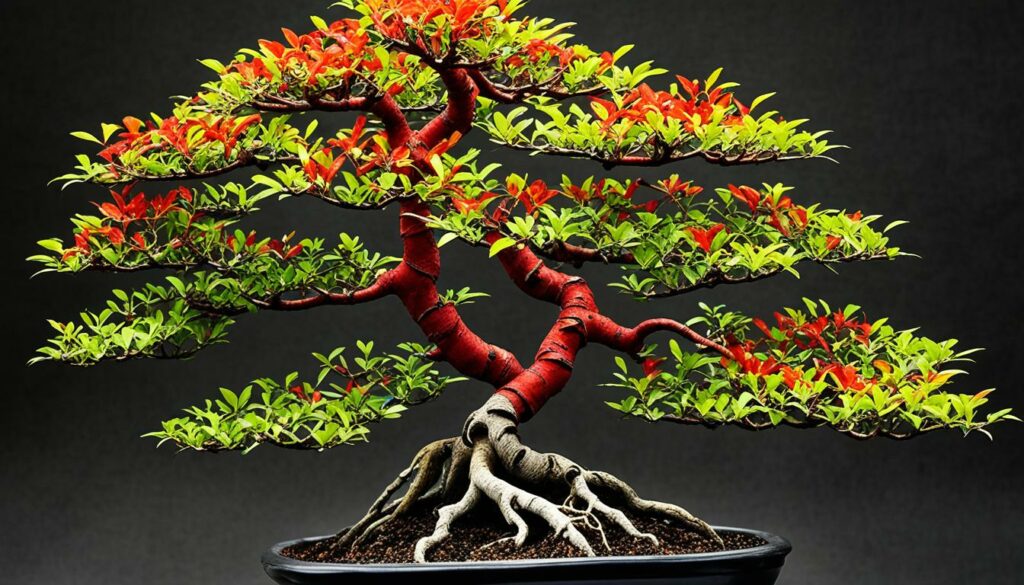
“The Zanthoxylum Bonsai is a sight to behold – a remarkable and unique addition to any bonsai collection. Its captivating aroma and fine foliage make it a rare gem in the bonsai community.”
The Art of Caring for a Chinese Pepper Bonsai
Proper care is essential for maintaining the beauty and health of your Chinese Pepper Bonsai. To ensure the longevity of this unique bonsai tree species, here are some essential care tips:
Watering
Avoid overwatering the Chinese Pepper Bonsai as it can be detrimental to its health. Make sure the soil is moist but not waterlogged. A proper watering schedule is crucial – during the growing season, water your Chinese Pepper Bonsai once every four to five days. As the temperature cools down, water it every seven to ten days.
Sunlight Requirements
The Chinese Pepper Bonsai thrives in partial shade or filtered sunlight. Avoid direct sunlight as it can scorch the leaves and damage the plant. If you are growing your Chinese Pepper Bonsai indoors, place it in a location that receives bright but indirect sunlight.
Pruning
Pruning is vital for shaping and maintaining the overall health of your Chinese Pepper Bonsai. Prune it during the growing season to encourage new growth. Trim back any branches that detract from the aesthetic appeal of your bonsai tree. Use sharp scissors or pruning shears to avoid injury to the plant.
Soil Preferences
The Chinese Pepper Bonsai prefers well-draining soil that is rich in organic matter. A 50/50 mixture of Akadama soil and coarse sand is ideal for this plant.
By following these essential care tips, your Chinese Pepper Bonsai will remain healthy and flourish for years to come.
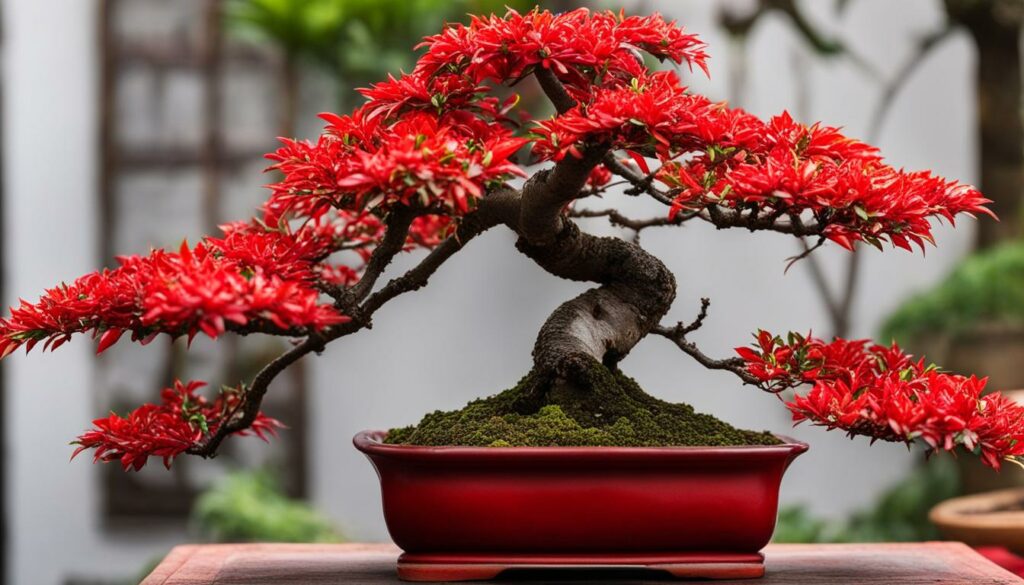
Propagating the Zanthoxylum Bonsai
Expanding your bonsai collection with unique species is an exciting prospect. If you’re interested in propagating Zanthoxylum bonsai, there are a few steps you can follow to ensure successful cultivation.
One of the easiest ways to propagate a Zanthoxylum bonsai is through seed germination. However, it’s important to use fresh seeds and be patient, as it can take up to several months for seedlings to emerge.
Another method is layering, where you encourage roots to grow from a branch still attached to the parent tree. Layering requires a bit more skill and patience, but it can produce a more established plant faster than starting from a seed.
Regardless of the propagation method you choose, proper care is essential to give your new Zanthoxylum bonsai a healthy start. Make sure to use the right soil mix, keep the soil moist but not too wet, and avoid over-fertilizing.
| Propagation Method | Pros | Cons |
|---|---|---|
| Seed Germination | Easy method, cost-effective, allows for genetic diversity. | Takes longer to produce a mature tree, may not be true to the parent tree. |
| Layering | Produces a more established plant faster than starting from seed, maintains true parent plant characteristics. | Requires more skill and patience, can be more expensive. |
Remember, propagating a Zanthoxylum bonsai requires patience, attention to detail, and knowledge of proper care techniques. But with dedication and perseverance, you can add this unique bonsai species to your collection and enhance your appreciation of these beautiful trees.
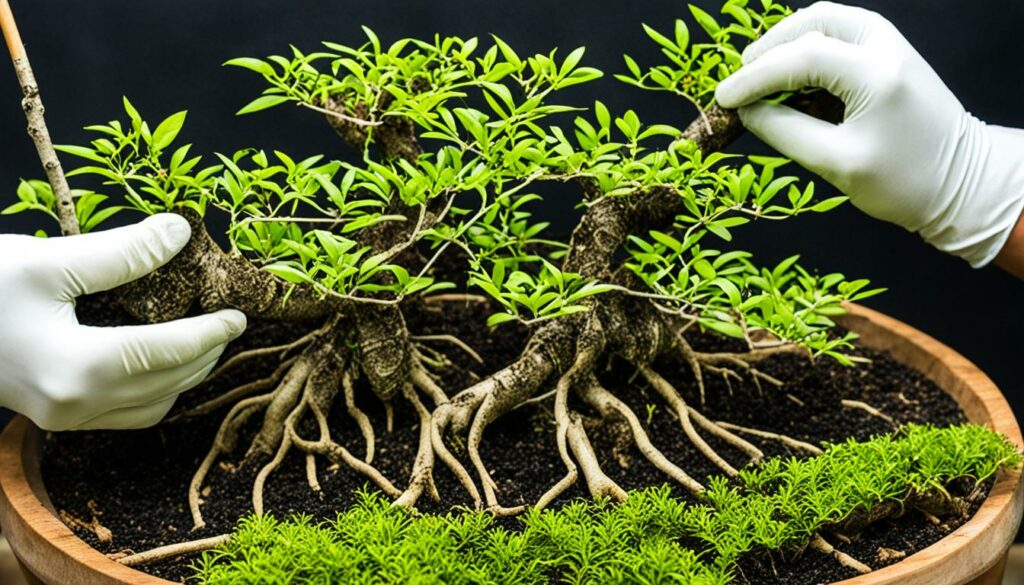
Styling and Shaping Techniques for the Chinese Pepper Bonsai
Creating an aesthetically pleasing Chinese Pepper Bonsai requires careful styling and shaping. With the right techniques and tools, you can bring out the unique beauty of this bonsai tree species. Here are some key tips to help you style and shape your Chinese Pepper Bonsai:
1. Choosing the Right Container
Choosing the right container is essential as it not only supports the plant but also complements the overall design. Consider the shape and size of the container to achieve balance and proportion. You may also opt for an unconventional container to add a touch of creativity to your display.
2. Wiring the Tree
Wiring is a common technique used to bend and shape the branches of the Chinese Pepper Bonsai. Use soft aluminum wire to wrap around the branches delicately. As you shape the tree, be careful not to bend the branches too much, and avoid creating sharp bends or kinks. Be gentle to avoid damaging the tree.
3. Pruning the Leaves
Pruning the leaves is an essential aspect of shaping the Chinese Pepper Bonsai. Remove any leaves that are blocking the view of the trunk and branches. Regular pruning helps to maintain the overall shape and appearance of the tree.
4. Creating Jin
Jin is the technique of creating deadwood on the tree to give it a more natural appearance. Use a grafting knife to strip the bark from the branches to create a jin effect. Ensure the jin looks natural and complements the tree’s overall shape.
5. Shaping the Roots
Shaping the roots of the Chinese Pepper Bonsai is vital in achieving balance and proportion. Use a root hook to tease out the roots, and prune away any unwanted ones. Trim the long, thick roots to allow for the tree to fit into the container easily.
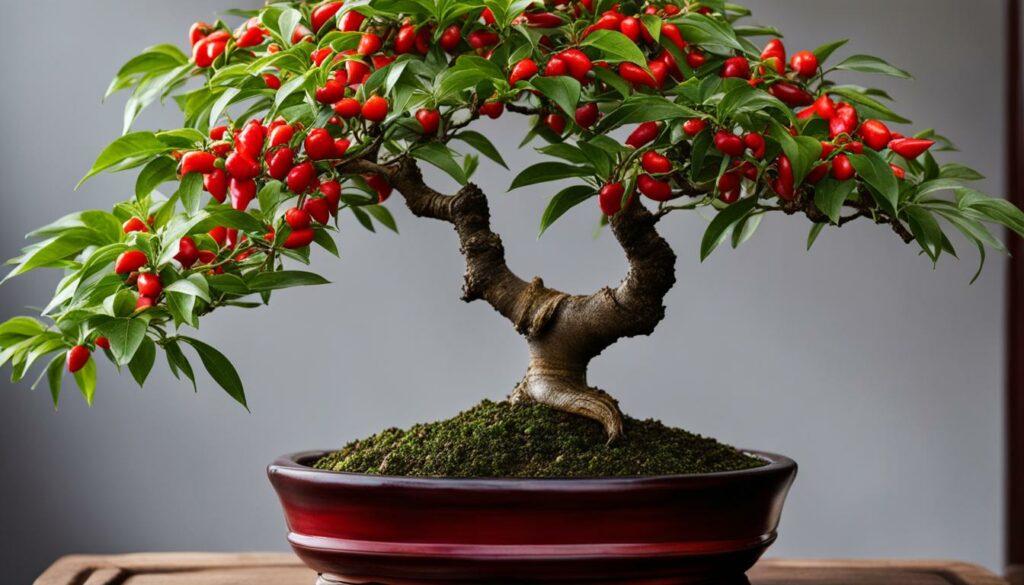
With these styling and shaping techniques, you can create a truly unique Chinese Pepper Bonsai. Remember to take your time and be patient as you work on your tree. Before you know it, you’ll have a stunning bonsai tree that is a testament to your hard work and dedication.
Chinese Pepper Bonsai Display Ideas
Displaying your Bonsai Tree Species Chinese Pepper is a form of art that requires creativity, skill, and knowledge of the plant’s needs. Here are some inspiring ideas to showcase your unique and beautiful Chinese Pepper Bonsai:
Traditional Display Styles
If you are a fan of traditional display styles, you can opt for the classic Bonsai display, which features a simple setup of a horizontal stand or table with a decorative accent. This minimalist approach highlights the natural beauty of your Zanthoxylum Bonsai.
Another classic option is the formal upright style, where the trunk of the Bonsai tree is straight and symmetrical, expressing elegance and refinement. The formal upright style works well with taller Chinese pepper bonsai plants, ideally positioned on a raised platform and framed with decorative stones or moss.
Modern Arrangements
If you prefer a more contemporary arrangement, you can explore various modern display options, such as the Cascade style, where the bonsai’s branches flow downwards, creating a waterfall-like effect. You can complement the Cascade style with a minimalist pot or container, drawing attention to the unique shape and curvature of your Zanthoxylum bonsai.
The forest style is also a popular contemporary display option, where multiple Bonsai trees are arranged together, creating the impression of a small forest. The forest style can be used to display multiple Chinese pepper bonsai plants at different stages of their growth, showcasing the unique characteristics of each Zanthoxylum Bonsai.
Decorative Accents
You can add decorative accents to your display to enhance the visual appeal of your Chinese pepper bonsai further. For example, you can place your Zanthoxylum Bonsai on a decorative rock or platform, which provides a natural background and highlights the unique shape of the plant.
You can also include a miniature figurine or animal in your display, bringing a whimsical touch to your Bonsai arrangement. Just ensure that the decorative piece is balanced and harmonious with your Zanthoxylum Bonsai and doesn’t overpower it.
Remember, when it comes to Bonsai display, the possibilities are endless, and you are only limited by your imagination. Experiment with different arrangements, styles and decorative accents to find the perfect display that showcases the unique beauty of your Bonsai Tree Species Chinese Pepper.
Troubleshooting Common Issues with the Zanthoxylum Bonsai
While caring for the unique Zanthoxylum Bonsai is a fulfilling experience, it is not without its challenges. In this section, we will explore common issues that may arise when tending to your Chinese Pepper Bonsai and how to address them effectively.
Pest Infestations
The Chinese Pepper Bonsai is vulnerable to pest infestations, especially spider mites, mealybugs, and scale insects. If left unchecked, these pests can cause extensive damage to the bonsai foliage and inhibit growth. To prevent pest infestations, inspect your Zanthoxylum Bonsai regularly and remove any infected leaves or branches. You can also use insecticidal sprays or natural remedies such as neem oil or soap solutions to control pests.
Yellowing Leaves
If you notice yellowing or browning leaves on your Chinese Pepper Bonsai, it may indicate a lack of nutrients or improper watering. Ensure you are providing your bonsai with adequate water, fertilizer, and soil composition. Overwatering or neglecting to fertilize can lead to waterlogged soil, root rot, and stunted growth. On the other hand, too little water or nutrients can cause your Zanthoxylum Bonsai to become dehydrated and nutrient deficient.
Diseases
Several diseases can affect the health of your Chinese Pepper Bonsai, including root rot, fungal infections, and bacterial wilt. Symptoms of infection include wilting leaves, spots, or discoloration on the foliage, and stunted growth. To prevent and treat diseases, ensure proper drainage, circulation, and hygiene when tending to your bonsai. You can also use fungicidal sprays or systemic treatments to combat microbial infections.
If you encounter any issues with your Zanthoxylum Bonsai, it is crucial to take immediate action to ensure the health and vitality of your bonsai. By providing proper care and attention, your Chinese Pepper Bonsai will thrive and continue to bring its unique charm to your bonsai collection.
Continual Learning and Appreciation of the Chinese Pepper Bonsai
Congratulations on embarking on a journey to cultivate your own Chinese Pepper Bonsai! As you continue to care for and admire your unique bonsai tree, there are many resources and communities that can deepen your understanding and appreciation of this species.
Online forums and social media groups dedicated to bonsai gardening are great places to connect with other enthusiasts, share tips and experiences, and learn from experts in the field.
You can also attend bonsai exhibitions, workshops, and events in your area to observe stunning displays, participate in demonstrations, and connect with like-minded individuals.
Books, magazines, and online publications can provide valuable insights on the history, origins, and cultural significance of the Chinese Pepper Bonsai, as well as offer tips on styling, shaping, and caring for your bonsai tree.
Remember, the journey of cultivating a bonsai tree is a continual learning process. Be open to new ideas, experiment with different techniques, and enjoy the unique beauty and charm of your Chinese Pepper Bonsai.
FAQ
What is a Chinese Pepper Bonsai?
A Chinese Pepper Bonsai, also known as Zanthoxylum Bonsai, is a unique bonsai tree species that belongs to the Zanthoxylum family. It is cultivated for its piquant charm, distinctive foliage, and captivating fragrance.
How do I care for a Chinese Pepper Bonsai?
Proper care is crucial for the thriving of a Chinese Pepper Bonsai. This includes regular watering, providing adequate sunlight, pruning to maintain shape and size, and using well-draining soil. It is also important to protect the bonsai from extreme temperatures and pests.
Can I propagate a Zanthoxylum Bonsai?
Yes, propagating a Zanthoxylum Bonsai is possible. One common method is through seed germination, which requires patience and careful nurturing. Other techniques include air layering and cutting propagation.
What styling and shaping techniques can I use for a Chinese Pepper Bonsai?
There are several styling and shaping techniques that can enhance the aesthetic appeal of a Chinese Pepper Bonsai. These include pruning to achieve balance and proportion, wiring to create unique shapes, and selecting appropriate pots and display styles.
How should I display my Chinese Pepper Bonsai?
Displaying a Chinese Pepper Bonsai requires careful consideration of the tree’s visual impact. Traditional display styles, such as formal upright or slanting, can highlight the bonsai’s elegance. Modern arrangements, such as cascade or semi-cascade, can add a contemporary touch. Experiment with different options to find a display style that complements the tree’s unique characteristics.
What are common issues that can arise when caring for a Zanthoxylum Bonsai?
Some common issues when caring for a Zanthoxylum Bonsai include pest infestation, such as scales or spider mites, and fungal or bacterial diseases. It is important to regularly inspect the bonsai for any signs of distress and promptly address these issues with appropriate treatments.
Are there resources available for further learning and appreciation of the Chinese Pepper Bonsai?
Yes, there are various resources, communities, and events that bonsai enthusiasts can explore to deepen their understanding and passion for the Chinese Pepper Bonsai. Online forums, books, workshops, and bonsai exhibitions provide opportunities for continual learning and connection with like-minded individuals.
